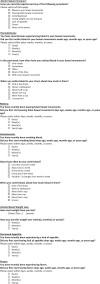Computer versus physician identification of gastrointestinal alarm features
- PMID: 26254875
- PMCID: PMC4762475
- DOI: 10.1016/j.ijmedinf.2015.07.006
Computer versus physician identification of gastrointestinal alarm features
Abstract
Objective: It is important for clinicians to inquire about "alarm features" as it may identify those at risk for organic disease and who require additional diagnostic workup. We developed a computer algorithm called Automated Evaluation of Gastrointestinal Symptoms (AEGIS) that systematically collects patient gastrointestinal (GI) symptoms and alarm features, and then "translates" the information into a history of present illness (HPI). Our study's objective was to compare the number of alarms documented by physicians during usual care vs. that collected by AEGIS.
Methods: We performed a cross-sectional study with a paired sample design among patients visiting adult GI clinics. Participants first received usual care by their physicians and then completed AEGIS. Each individual thus contributed both a physician-documented and computer-generated HPI. Blinded physician reviewers enumerated the positive alarm features (hematochezia, melena, hematemesis, unintentional weight loss, decreased appetite, and fevers) mentioned in each HPI. We compared the number of documented alarms within patient using the Wilcoxon signed-rank test.
Results: Seventy-five patients had both physician and AEGIS HPIs. AEGIS identified more patients with positive alarm features compared to physicians (53% vs. 27%; p<.001). AEGIS also documented more positive alarms (median 1, interquartile range [IQR] 0-2) vs. physicians (median 0, IQR 0-1; p<.001). Moreover, clinicians documented only 30% of the positive alarms self-reported by patients through AEGIS.
Conclusions: Physicians documented less than one-third of red flags reported by patients through a computer algorithm. These data indicate that physicians may under report alarm features and that computerized "checklists" could complement standard HPIs to bolster clinical care.
Keywords: Alarm features; Checklists; Patient-provider portal.
Copyright © 2015. Published by Elsevier Ireland Ltd.
Figures



References
-
- Blumenthal D. Launching HITECH. N. Engl. J. Med. 2010;362:382–385. - PubMed
-
- DesRoches CM, Charles D, Furukawa MF, et al. Adoption of electronic health records grows rapidly, but fewer than half of US hospitals had at least a basic system in 2012. Health Aff. (Millwood) 2013;32:1478–1485. - PubMed
-
- Miller RH, Sim I. Physicians’ use of electronic medical records: barriers and solutions. Health Aff. (Millwood) 2004;23:116–126. - PubMed
-
- Handler T, Holtmeier R, Metzger J, et al. HIMSS electronic health record definitional model version 1.0. The Healthcare Information and Management Systems Society (HIMSS) Electronic Health Record Committee; 2003.
Publication types
MeSH terms
Grants and funding
LinkOut - more resources
Full Text Sources
Other Literature Sources

